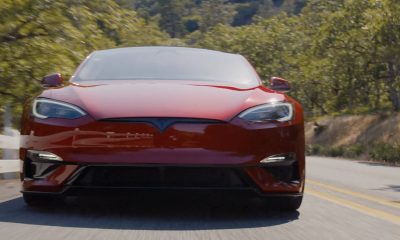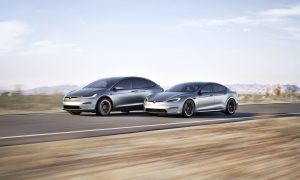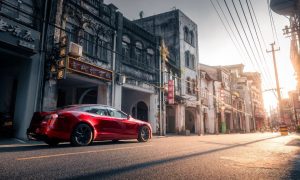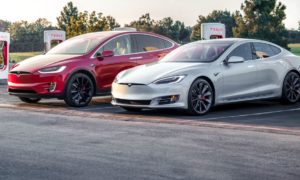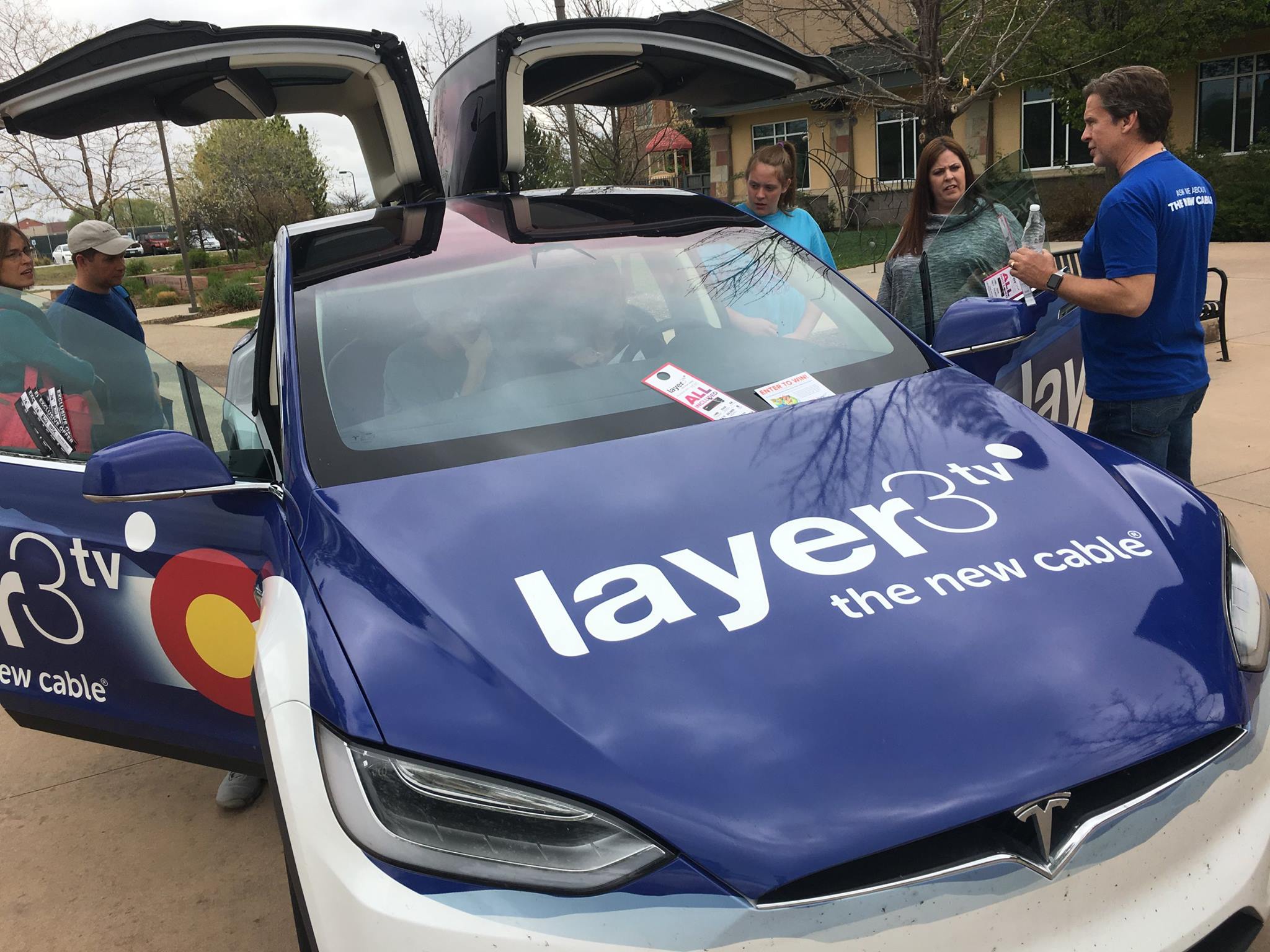

News
Layer3 TV plans to use 100 Tesla Model X fleet to deliver next-gen cable
Denver-based Layer3 TV, a next generation cable television service provider, is switching its service vehicles to a Tesla Model X fleet as the company aims to redefine the antiquated cable TV industry using modern day technologies. Layer3’s CEO Jeff Binder said that the company’s biggest advantage is in video quality, citing “It’s unanimous”.
With plans to purchase 100 Model X vehicles by the end of the year, Binder claims that the savings from their unique installation process and the low maintenance cost of the Model X enables the company to reap “substantial” savings. Their installation costs are nearly 50% lower than competitors, enabling the company to expand the Model X fleet and creating a “win-win” scenario.
“It’s a pretty different experience… Who doesn’t like driving a Model X?” – Layer3 TV CEO Jeff Binder
The company, founded in 2013 by cable veterans Jeff Binder and Dave Fellows, raised nearly $100M to fund its big plans to disrupt the cable service provider industry. Layer3 TV tells Teslarati that they had purchased a Model X to deliver their new service in Colorado earlier this year, and recently expanded the fleet nationwide. Layer3 currently services Chicago, Washington DC, Los Angeles, Dallas, and parts of Denver. While Binder didn’t release any subscriber numbers, he said the company is seeing double digit growth month-over-month.
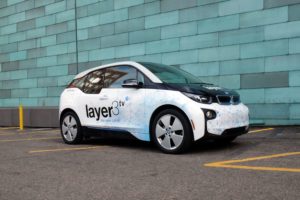
Layer3 Originally planned to have a fleet of BMW i3s, but ultimately decided the Model X better fit their needs.
Multichannel reported that Layer3 TV is using a fleet of Teslas for their Colorado rollout stating, “For the rollout with NextLight in Longmont, Layer3 TV is using a fleet of Tesla vehicles to perform installs and other customer visits.” Layer3 TV initially envisioned using a fleet of BMW i3s but decided to go with the Tesla Model X after determining that they needed more space, all wheel drive, and more range.
The company plans to have a fleet of roughly 100 Teslas by the end of the year and currently has the Model X deployed in all of their markets. Jeff Binder told Teslarati via phone, “There is no downside… we are spending half as much as the competition on installs, our installers love the vehicles, it’s sustainable, and we get great marketing out of the vehicles.”
100 Tesla Model X Fleet
Layer3’s fleet of Model Xs are presumably the largest in the world, as not many company’s have adopted commercial uses for the vehicle. Binder told Teslarati that they haven’t adopted any custom fleet management systems in the Model X that’s out of the norm, but definitely plans to take advantage of the Model X’s large center screen. Binder is a bit surprised that Tesla doesn’t have much of a fleet management system, and hopes the company will develop such a program.

Layer3 has deployed their fleet nationwide, and plans to continue adding more vehicles to the fleet. Photo: Layer3 TV
Layer3 stated back in March, “Not only do we provide quick installs, but we do it in a Tesla. Rodney (a Layer3 TV installer) installs 6 boxes in a day with our eco-friendly Tesla.”
Before the company launched their service last year they had planned to deliver the service in the BMW i3. Layer3 is aiming to be the new “upscale” cable provider, while the company doesn’t lay its own fiber or cable lines, it delivers the service through advanced video technology riding through leased fiber and private IP. You can see if Layer3 TV is in available in your area.

Picking the Tesla Model X looks like the perfect way to show customers that they aren’t doing business in the usual way which stereotypically includes late arrivals and in a beat-up white van.
The nex-gen cable TV provider has released a video showing off their new wrap which we find simply stunning. Check out the video below to see how Layer3 TV “tricked out” their Model X!
https://www.facebook.com/inkmonstr/videos/1504959446214814/
https://instagram.com/p/BSv8UHOgGQ9/
News
Tesla UK sales see 14% year-over-year rebound in June: SMMT data
The SMMT stated that Tesla sales grew 14% year-over-year to 7,719 units in June 2025.

Tesla’s sales in the United Kingdom rose in June, climbing 14% year-over-year to 7,719 units, as per data from the Society of Motor Manufacturers and Traders (SMMT). The spike in the company’s sales coincided with the first deliveries of the updated Model Y last month.
Model Y deliveries support Tesla’s UK recovery
Tesla’s June performance marked one of its strongest months in the UK so far this year, with new Model Y deliveries contributing significantly to the company’s momentum.
While the SMMT listed Tesla with 7,719 deliveries in June, independent data from New AutoMotive suggested that the electric vehicle maker registered 7,891 units during the month instead. However, year-to-date figures for Tesla remain 2% down compared to 2024, as per a report from Reuters.
While Tesla made a strong showing in June, rivals are also growing. Chinese automaker BYD saw UK sales rise nearly fourfold to 2,498 units, while Ford posted the highest EV growth among major automakers, with a more than fourfold increase in the first half of 2025.
Overall, the UK’s battery electric vehicle (BEV) demand surged 39% to to 47,354 units last month, helping push total new car sales in the UK to 191,316 units, up 6.7% from the same period in 2024.
EV adoption accelerates, but concerns linger
June marked the best month for UK car sales since 2019, though the SMMT cautioned that growth in the electric vehicle sector remains heavily dependent on discounting and support programs. Still, one in four new vehicle buyers in June chose a battery electric vehicle.
SMMT Chief Executive Mike Hawes noted that despite strong BEV demand, sales levels are still below regulatory targets. “Further growth in sales, and the sector will rely on increased and improved charging facilities to boost mainstream electric vehicle adoption,” Hawes stated.
Also taking effect this week was a new US-UK trade deal, which lowers tariffs on UK car exports to the United States from 27.5% to 10%. The agreement could benefit UK-based EV producers aiming to expand across the country.
News
Tesla Model 3 ranks as the safest new car in Europe for 2025, per Euro NCAP tests
Despite being on the market longer than many of its rivals, the Tesla Model 3 continues to set the bar for vehicle safety.

The Tesla Model 3 has been named the safest new car on sale in 2025, according to the latest results from the Euro NCAP. Among 20 newly tested vehicles, the Model 3 emerged at the top of the list, scoring an impressive 359 out of 400 possible points across all major safety categories.
Tesla Model 3’s safety systems
Despite being on the market longer than many of its rivals, the Tesla Model 3 continues to set the bar for vehicle safety. Under Euro NCAP’s stricter 2025 testing protocols, the electric sedan earned 90% for adult occupant protection, 93% for child occupant protection, 89% for pedestrian protection, and 87% for its Safety Assist systems.
The updated Model 3 received particular praise for its advanced driver assistance features, including Tesla’s autonomous emergency braking (AEB) system, which performed well across various test scenarios. Its Intelligent Speed Assistance and child presence detection system were cited as noteworthy features as well, as per a WhatCar report.
Other notable safety features include the Model 3’s pedestrian-friendly pop-up hood and robust crash protection for both front and side collisions. Euro NCAP also highlighted the Model 3’s ability to detect vulnerable road users during complex maneuvers, such as turning across oncoming traffic.
Euro NCAP’s Autopilot caution
While the Model 3’s safety scores were impressive across the board, Euro NCAP did raise concerns about driver expectations of Tesla’s Autopilot system. The organization warned that some owners may overestimate the system’s capabilities, potentially leading to misuse or inattention behind the wheel. Even so, the Model 3 remained the highest-scoring vehicle tested under Euro NCAP’s updated criteria this year.
The Euro NCAP’s concerns are also quite interesting because Tesla’s Full Self-Driving (FSD) Supervised, which is arguably the company’s most robust safety suite, is not allowed for public rollout in Europe yet. FSD Supervised would allow the Model 3 to navigate inner city streets with only minimal human supervision.
Other top scorers included the Volkswagen ID.7, Polestar 3, and Geely EX5, but none matched the Model 3’s total score or consistency across categories. A total of 14 out of 20 newly tested cars earned five stars, while several models, including the Kia EV3, MG ZS, and Renault 5, fell short of the top rating.
Elon Musk
Why Tesla’s Q3 could be one of its biggest quarters in history
Tesla could stand to benefit from the removal of the $7,500 EV tax credit at the end of Q3.

Tesla has gotten off to a slow start in 2025, as the first half of the year has not been one to remember from a delivery perspective.
However, Q3 could end up being one of the best the company has had in history, with the United States potentially being a major contributor to what might reverse a slow start to the year.
Earlier today, the United States’ House of Representatives officially passed President Trump’s “Big Beautiful Bill,” after it made its way through the Senate earlier this week. The bill will head to President Trump, as he looks to sign it before his July 4 deadline.
The Bill will effectively bring closure to the $7,500 EV tax credit, which will end on September 30, 2025. This means, over the next three months in the United States, those who are looking to buy an EV will have their last chance to take advantage of the credit. EVs will then be, for most people, $7,500 more expensive, in essence.
The tax credit is available to any single filer who makes under $150,000 per year, $225,000 a year to a head of household, and $300,000 to couples filing jointly.
Ending the tax credit was expected with the Trump administration, as his policies have leaned significantly toward reliance on fossil fuels, ending what he calls an “EV mandate.” He has used this phrase several times in disagreements with Tesla CEO Elon Musk.
Nevertheless, those who have been on the fence about buying a Tesla, or any EV, for that matter, will have some decisions to make in the next three months. While all companies will stand to benefit from this time crunch, Tesla could be the true winner because of its sheer volume.
If things are done correctly, meaning if Tesla can also offer incentives like 0% APR, special pricing on leasing or financing, or other advantages (like free Red, White, and Blue for a short period of time in celebration of Independence Day), it could see some real volume in sales this quarter.
You can now buy a Tesla in Red, White, and Blue for free until July 14 https://t.co/iAwhaRFOH0
— TESLARATI (@Teslarati) July 3, 2025
Tesla is just a shade under 721,000 deliveries for the year, so it’s on pace for roughly 1.4 million for 2025. This would be a decrease from the 1.8 million cars it delivered in each of the last two years. Traditionally, the second half of the year has produced Tesla’s strongest quarters. Its top three quarters in terms of deliveries are Q4 2024 with 495,570 vehicles, Q4 2023 with 484,507 vehicles, and Q3 2024 with 462,890 vehicles.
-

 Elon Musk4 days ago
Elon Musk4 days agoTesla investors will be shocked by Jim Cramer’s latest assessment
-

 News1 week ago
News1 week agoTesla Robotaxi’s biggest challenge seems to be this one thing
-

 Elon Musk2 weeks ago
Elon Musk2 weeks agoFirst Look at Tesla’s Robotaxi App: features, design, and more
-

 News2 weeks ago
News2 weeks agoSpaceX and Elon Musk share insights on Starship Ship 36’s RUD
-

 News2 weeks ago
News2 weeks agoWatch Tesla’s first driverless public Robotaxi rides in Texas
-

 News1 week ago
News1 week agoWatch the first true Tesla Robotaxi intervention by safety monitor
-

 News2 weeks ago
News2 weeks agoTesla has started rolling out initial round of Robotaxi invites
-

 Elon Musk2 weeks ago
Elon Musk2 weeks agoTesla to launch in India in July with vehicles already arriving: report


